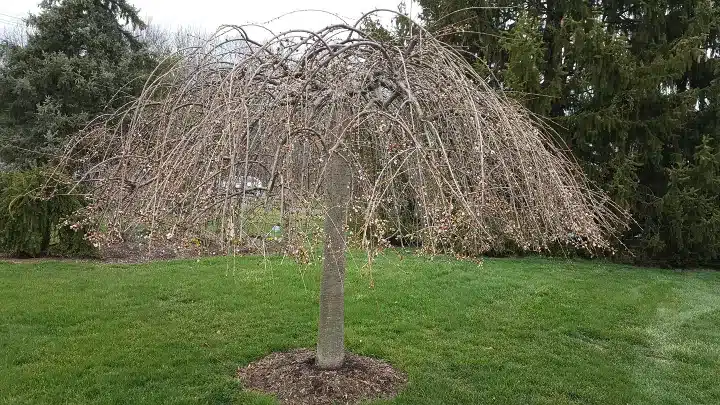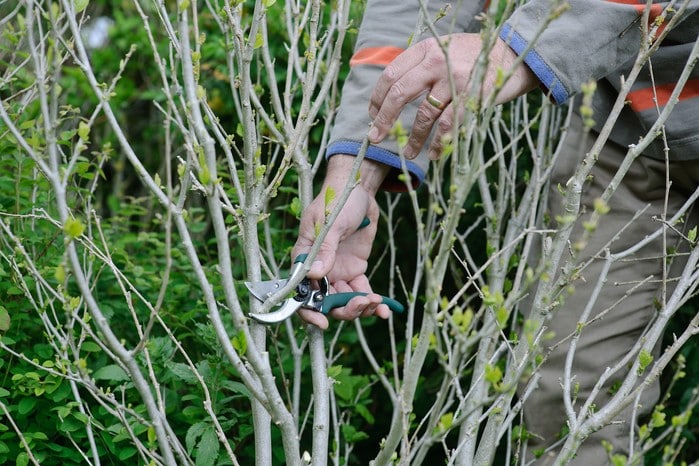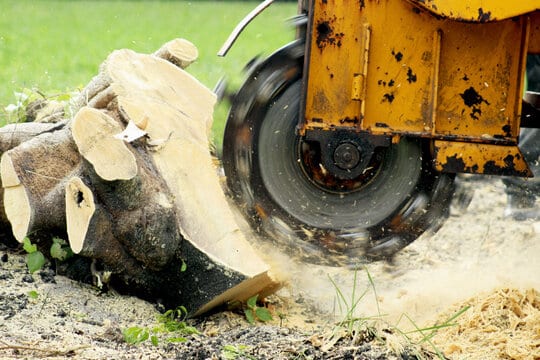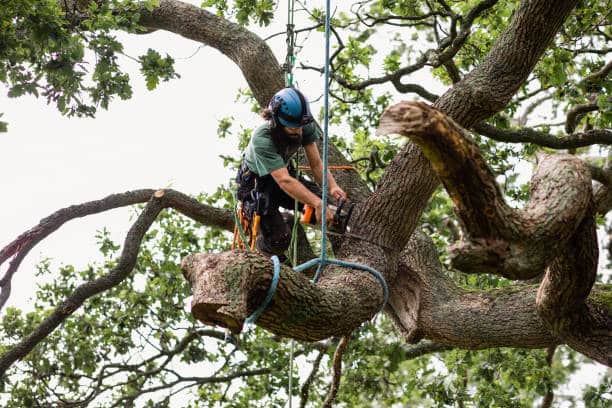Trimming a weeping cherry tree demands meticulous attention to detail and the right technique to maintain the tree’s health and aesthetic appeal. At Atascocita Arborist, we realize how important it is to preserve trees like the weeping cherry to improve the attractiveness of your environment while also increasing their longevity. In this post, we’ll walk you through the necessary stages and techniques for trimming a weeping cherry tree.
Reasons to trim a weeping cherry tree
Trimming a weeping cherry tree is necessary for various reasons, including maintaining its health, beauty, and structural integrity.
Regular pruning removes dead, diseased, or damaged branches, which prevents disease spread and improves overall tree health.
Pruning helps to keep the tree’s shape and fosters a balanced canopy, which improves its natural beauty and aesthetic appeal in your landscape.
Proper pruning promotes new development by directing the tree’s energy to healthy branches and buds, resulting in fuller foliage and plentiful blossoms.
Trimming removes weak or overextended branches that could fall during a storm or obstruct routes.
Thinning out congested branches improves air circulation inside the canopy, lowering the risk of fungal diseases and increasing tree vigor.
Pruning ensures that the tree’s size is appropriate for its environment, preventing overpopulation and maintaining harmony in your garden or yard.
Signs that your weeping cherry tree requires trimming
Identifying when your weeping cherry tree needs trimming is critical to preserving its health and appearance. Here are the signs to watch for:

Pruning may be necessary if the limbs of your weeping cherry tree appear crowded or twisted. Overcrowded branches can limit airflow and sunshine, perhaps resulting in illness or diminished flowering.
Look for decaying, discolored, or lacking foliage. Remove dead or diseased branches immediately to prevent future spread and enhance the overall health of the tree.
When branches cross or rub together, they can cause damage and provide entry points for pests and diseases. Trimming these branches helps to preserve the tree’s structure and integrity.
Remove any branches that represent a threat, such as those that overhang structures or block pathways.
Regularly checking your weeping cherry tree for these symptoms will allow you to identify when trimming is required to promote its health and lifespan.
Gather the right tools
Pruning shears for thinner branches
Loppers for heavier branches
Handsaw for greater cuts
Safety equipment such as gloves and glasses are necessary for all possible scenarios.
How to trim a weeping cherry tree?
Trimming a weeping cherry tree demands accuracy and care to keep it looking lovely and healthy. Here’s a full tutorial on trimming a weeping cherry tree, along with some useful tips:
Assess the Tree: Begin by thoroughly inspecting the tree from every angle. Check for dead, diseased, or damaged branches, and any crossing or rubbing branches that could impede growth.
Identify Dead or Diseased Branches: Gently remove any dead or diseased branches; use pruning shears or loppers. To avoid disease spreading, cut them back to their original location or a healthy bud.
Thin crowded branches: To improve air circulation and sunlight penetration within the canopy, strategically thin out crowded branches. Remove branches that cross or rub against each other, beginning with those nearest the trunk.
Shape the Tree: Maintain the cherry tree’s weeping form, prune for shape. Trim longer branches to create a balanced silhouette while maintaining the tree’s natural beauty.
Prune with precision: Always prune slightly outside the branch collar, which is the swelling area where the branch connects with the trunk or another branch. Avoid leaving stubs, as they can attract bugs and cause deterioration.
Consider the three Ds: When determining which branches to cut, prioritize those that are dead, diseased, or damaged. Initially, removing these branches will improve the tree’s overall health.
Take Your Time: Trimming a weeping cherry tree is not something to speed through. Take your time evaluating each branch before cutting, and take regular breaks to monitor your work.
Clean Up Thoroughly: After you’ve finished trimming the tree, make sure to clean up the space around it. To prevent pests and diseases from spreading, remove all debris and properly dispose of it.
Monitoring Growth: After cutting, keep an eye on the tree’s growth throughout the season. During dry spells, water the tree, and apply a balanced fertilizer in early spring to encourage strong foliage and blossoms.
How to trim a grafted weeping cherry tree.
Identify the Graft Union: The graft union is typically a bulging area around the base of the tree where the weeping branches meet the rootstock. This area is important to protect since it ensures the tree’s vigor and growth.
Remove dead or diseased branches: Trim the weeping branches to keep the tree in its ideal shape and form. Use pruning shears or loppers to remove dead, diseased, or crossed branches.
Sucker Management: Keep an eye out for suckers, which are robust shoots that possibly, emerge from the rootstock below the graft union. Remove these suckers as soon as possible, as they drain energy from the weeping branches.
Avoid Pruning Below Graft Union: Never prune below the graft union since it can jeopardize the tree’s health and cause rootstock growth, affecting the weeping cherry’s look.
Dormant season: Trim the grafted weeping cherry tree while it is dormant, i.e., from late winter to early spring. This scheduling relieves stress on the tree and facilitates the quick healing of pruning wounds.
Clean Tools: For nice cuts, always use sharp and clean pruning tools. If you suspect a disease, disinfect your instruments between cuts to keep it from spreading to other sections of the tree.
To monitor the tree’s growth, inspect it regularly throughout the growing season. Keep an eye out for new growth, and adjust trimming as needed to keep the tree in good shape and healthy.
Related Posts:
Techniques for proper cuts while trimming
Making precise cuts while trimming a weeping cherry tree is critical to promoting healing and reducing the tree’s stress. Here’s how to make the right cut:
Use Sharp Tools: Make sure your pruning shears, loppers, or saws are sharp and clean. Dull blades can crush tissue and create jagged incisions that take longer to heal.
Identify the Branch Collar: Look for a slightly swollen area where the branch meets the trunk or another branch. This area is home to specific cells that aid the tree’s healing process.
Branch collar: Cut just outside the branch collar. Cutting too close can damage the collar while cutting too far away results in a stub that attracts bugs and causes deterioration.
Diagonal cut: Make a smooth, diagonal cut at a 45-degree angle. This angle helps to shed water from the wounded surface and promotes faster healing.
Cutting Technique: Begin the cut at the bottom of the branch, approximately 6–12 inches from the collar. To avoid damaging the bark, cut through the branch in one continuous motion.
Inspect After Cutting: After making the cut, examine the wound. Make sure it is clean and smooth, with no ragged corners.
FAQS
When is the ideal time to trim a weeping cherry tree?
Trimming is most effective between late winter and early spring when the tree is dormant. This time, which normally lasts from late February to early April, reduces stress on the tree and facilitates faster wound healing from pruning.
How much should I trim my weeping cherry?
Pruning should be done selectively rather than excessively. Remove dead, diseased, or crossing branches while preserving the tree’s natural shape and form. To avoid stress, do not remove more than 25% of the tree’s canopy in a single pruning session.
Can I prune my weeping cherry tree in the summer or fall?
Pruning weeping cherry trees throughout the summer and fall is generally not suggested. Pruning during these seasons may stimulate new growth that does not harden before winter, leaving the tree vulnerable to cold damage. Pruning is best done between late winter and early spring.
How should I prune weeping cherry tree branches that are too low or obstruct pathways?
Low-hanging or blocking branches should be carefully removed with pruning shears or loppers. To provide a neat cut, trim back just outside the branch collar. To retain the tree’s visual appeal, prune it according to its natural form.
What do I do after trimming my weeping cherry tree?
After cutting the tree, tidy up trash around it to avoid pests and diseases. Monitor the tree’s growth throughout the season, supply enough water during dry spells, and consider fertilising in early spring to encourage healthy regeneration.
Conclusion
To summarize, careful pruning of your weeping cherry tree is critical for maintaining its health, improving its appearance, and ensuring its success in your environment. At Atascocita Arborist, we highlight the need for pruning in the proper season, late winter to early spring, to reduce stress and encourage speedy healing. By strategically pruning dead, diseased, or crossing branches while retaining the tree’s natural shape, you can improve air circulation, sunlight penetration, and overall vitality.
Meta Description
Discover expert tips on how to trim a weeping cherry tree for optimal health and beauty. At Atascocita Arborist, we provide professional tree trimming services to enhance your landscape.






